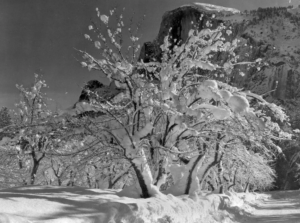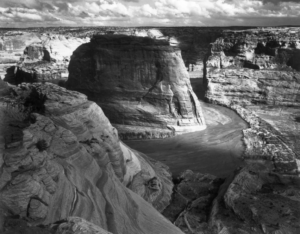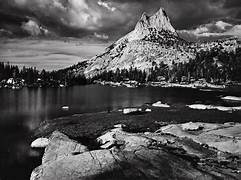
Ansel Adams, born in 1902 in San Francisco, was a pioneering figure in photography, well known for his meticulous attention to detail and profound artistic vision. His work revolutionised landscape photography, showcasing the beauty of the American West through precise technical execution and emotional depth. Using techniques like the Zone System, Adams achieved great control over exposure and tonal range, creating timeless images that capture the essence of nature’s beauty. Beyond his artistry, Adams was a passionate advocate for conservation, leaving a lasting legacy that continues to inspire photographers and environmentalists worldwide.
I wanted to analyse it and educate myself about Ansel Adams due to the romanticised look of his images, as well as the journey he takes in order to capture such extravagant photographs. The motive behind his images relate to my key themes, observe, seek and challenge. Especially my own set values which revolve around travel and adventure. After analysing Ansel Adams, I hope to produce similar photographs, or photographs of the same/similar values.



He assisted a photographers’ association promoting the principles of “pure” photography, emphasising sharp focus and maximising the tonal range in images. This collective, known as Group f/64, took its name from the smallest aperture achievable on large format cameras, the type Ansel and his team utilised. These cameras offered remarkable depth of field and exceptional detail owing to their large negatives. However, their considerable weight made them bulky and impractical, especially when navigating to remote locations with intriguing backgrounds. Additionally, the associated equipment added to the logistical challenge due to its bulkiness.
To ensure all the tonal values are shown in a photograph , he came up with the zone system, this system is said to make the “perfect” photograph and he would often make his photos darker then the original or the ones he would firstly take.

Zooming into one of his images to the point where it is so pixelated and the little coloured squares show a range of colours , where each square is a different shade of black &white, supporting his zone system.


Ansel Adams is renowned not only for his photographic skills but also for his dedication to visualizing images exactly as he conceived them in his mind’s eye. Recognizing the difference between what he perceived and what the camera captured, he began a quest to close this gap. Through experimentation, he aimed to translate his mental images successfully onto film.



In one example, Adams used a yellow filter with his camera in an attempt to replicate a specific effect. However, he found that the result did not align with his desired outcome, instead of enhancing the shadows as intended, the image did not turn out how he intended it to be. Determined, Adams insisted for perfection. Substituting the yellow filter for a red one, he tried to achieve the desired darkening and accentuation of shadows, materialising the image he envisioned in his mind. Though what he captured through the lens may have mirrored what he saw, it was the image within his imagination that drove his creative success.

Ansel Adams, a pioneering figure in photography, introduced many innovative techniques, including the Zone System. However, his influence extended further than technical innovations, he also left behind a legacy of inspiring quotes. Among them, the one above, resonates deeply with me, embodying a profound significance. This particular quote underscores the essence of Adams’ approach to photography, emphasising the power of visualisation inherent in each image. “Expression of one feels” captures the core philosophy of photography. Photography, in my opinion, should serve as a medium for individuals to express themselves creatively, sharing their emotions and experiences through visual storytelling.
Adams’ view that photography is an expression of one’s inner feelings resonates with me on a personal level. It speaks to the fundamental purpose of photography—to capture not only what is seen but also what is felt. For Adams, this aspect of photography was most important. It was about more than just technical skill, it was about capturing his vision, emotions, and thought processes through his photographs.

Take the image above as a good example of Ansel Adams’ technique. Even though it’s in black and white, the richness of tones on display is eye-catching. These tones are cleverly balanced. When envisioning this composition, Adams not only selected an interesting subject but also timed his shot perfectly, relying on the sun’s angle to cast sharp highlights across the scene. The resulting darker effect, achieved through strategic manipulation, leads to a sense of the sublime—a strong mix of awe and trepidation. In contemporary terms, copying such an effect would tell a deliberate exaggeration of shadows and dark areas, adding a layer of drama to the composition. Overall, this image shows Adams’ mastery of both technical precision and artistic vision, inviting viewers to contemplate the profound beauty inherent in the natural world.
Personally I wanted to educate myself on his work as his images have a mystery behind them and aren’t just simple block&white images. If the images were taken now this effect would be achievable through editing and adjusting exposure, darkness, shadows, brightness etc. However whats so amazing is that he achieved this by changing a colour that he put over the lens. It his experimentation that I find ambitious and determination to achieve the exact image that he inspires to, and wont give up until he produces exactly that.
In conclusion, Adams viewed photography as a means of sharing his inner self with the world. A sentiment that I find deeply amusing and one that continues to guide my own approach to the art form. Now that I have a deeper understanding of his images, but more importantly the stories that they tell, I am confident to produce my own responses with the same values. I want to focus on the trip and adventure behind the motive of photoshoots, as well as capturing discoveries and desired final outcomes.